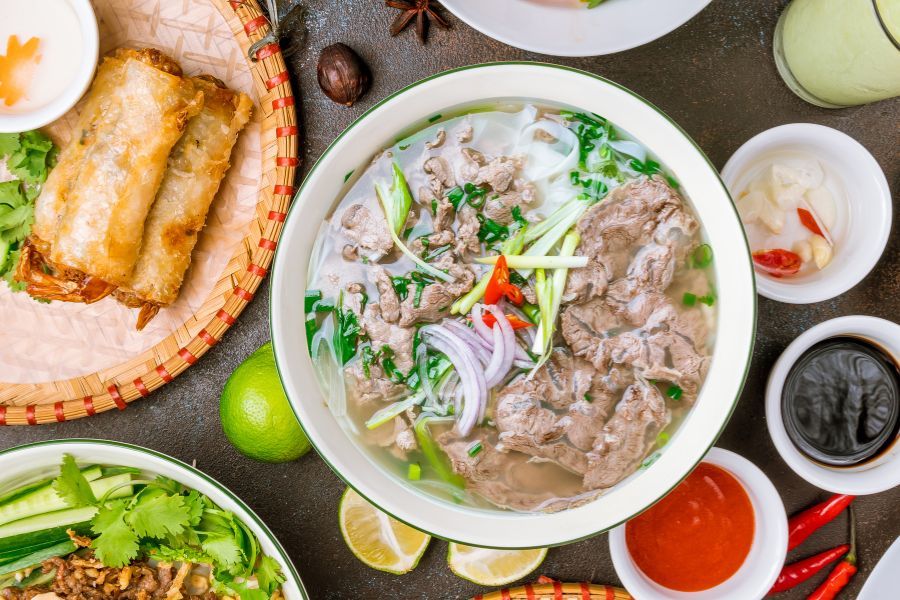Vietnamese cuisine is renowned for its fresh ingredients, minimal use of dairy and oil, and a balance between herbs and meats. It’s a delightful symphony of flavors and textures that reflects the country’s geography, history, and cultural diversity.
Key Characteristics of Vietnamese Cuisine
Balance of Flavors:
Vietnamese dishes are characterized by a delicate balance of flavors: sweet, salty, sour, bitter, and spicy. This harmony is achieved through the use of fish sauce, soy sauce, rice vinegar, lemongrass, ginger, mint, Vietnamese mint, long coriander, Saigon cinnamon, bird’s eye chili, lime, and basil leaves.
Fresh Herbs and Vegetables:
Fresh herbs and vegetables are fundamental in Vietnamese cooking. They are often served raw and added to dishes just before eating to maintain their freshness and crunch. Common herbs include cilantro, mint, Thai basil, and perilla leaves.
Rice:
Rice is a staple in Vietnamese cuisine and is used in various forms, from steamed rice to rice noodles and rice paper. It forms the base for many traditional dishes.
Popular Vietnamese Dishes
Phở:
Perhaps the most famous Vietnamese dish, phở is a noodle soup consisting of broth, rice noodles, herbs, and meat, usually beef or chicken. The broth is typically simmered for hours with spices such as star anise, cinnamon, and cloves, giving it a deep and aromatic flavor.

Bánh Mì:
Bánh mì is a French-inspired Vietnamese sandwich that combines a crispy baguette with various fillings, including pâté, cold cuts, pickled vegetables, cilantro, and chili. It’s a perfect example of Vietnam’s colonial history influencing its cuisine.
Gỏi Cuốn (Spring Rolls):
Gỏi cuốn, also known as fresh spring rolls, are made with shrimp, pork, fresh vegetables, vermicelli noodles, and herbs, all wrapped in rice paper. They are often served with a dipping sauce made from hoisin sauce and peanut butter.
Bún Chả:
Bún chả is a Hanoi specialty consisting of grilled pork served over a plate of white rice noodles with herbs and a side of dipping sauce. The dish gained international fame when former U.S. President Barack Obama dined on it during his visit to Vietnam.
Cao Lầu:
Cao lầu is a regional Vietnamese dish from the town of Hội An. It consists of thick rice noodles, pork, and local greens, often accompanied by crispy wonton crackers. The noodles are traditionally prepared with water from a specific local well, giving them a unique texture and flavor.
Bánh Xèo:
Bánh xèo, meaning “sizzling cake,” is a crispy, savory pancake made from rice flour, water, and turmeric powder, stuffed with shrimp, pork, bean sprouts, and green onions. It is typically wrapped in lettuce leaves and dipped in a mixture of fish sauce and lime juice.
Chả Cá Lã Vọng:
Chả cá Lã Vọng is a famous Hanoi dish featuring fish marinated with turmeric and dill, then fried and served with rice noodles, peanuts, and herbs. It is named after a restaurant in Hanoi that specializes in this dish.
Regional Variations
Vietnamese cuisine varies significantly between the north, central, and southern regions of the country:
Northern Vietnam: The cuisine here is characterized by its subtle flavors and reliance on soy sauce, fish sauce, and black pepper. Dishes often include freshwater fish, crab, and prawns.
Central Vietnam: Known for its spicy food, the central region uses chili peppers and shrimp sauce. The dishes are often more complex, with many small servings served together.
Southern Vietnam: The cuisine in the south is known for its sweeter flavors, influenced by the use of coconut milk and sugar. The fertile Mekong Delta provides an abundance of fruits, vegetables, and fish.
The Role of Street Food
Street food is an integral part of Vietnamese culture. It’s not just about eating; it’s a social activity where people gather, chat, and enjoy food together. Some popular street food items include bánh mì, phở, and various types of noodle soups and rice paper rolls.
Conclusion
Vietnamese cuisine is a celebration of fresh ingredients, balanced flavors, and regional diversity. Whether you’re savoring a bowl of steaming phở, biting into a crispy bánh mì, or enjoying the vibrant street food scene, Vietnamese food offers a culinary experience that is both rich in tradition and delightful to the senses.
Plan Your Culinary Adventure in Vietnam Today!
#VietnameseCuisine #TravelVietnam #Pho #BanhMi #SpringRolls #CulinaryAdventure #ExploreVietnam

0 Comment